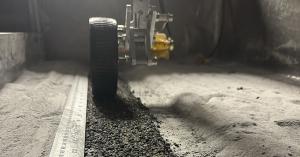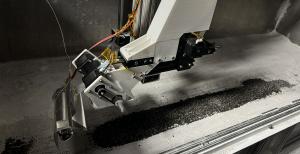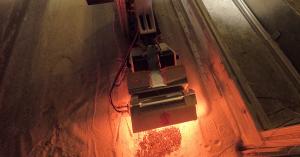Lunar Inroads: SpaceFactory and MTU Complete First Lunar "Road" in Vacuum

The SpaceFactory-MTU team successfully paved a lunar “road” in space-like conditions, driving 720 meters over the trackway.
Groundbreaking partnership advances lunar infrastructure technology with first-ever road built using lunar-like regolith in a simulated space environment.
The SpaceFactory-MTU project brought forth several innovative engineering strategies designed to maximize the utility of lunar regolith, an abundant resource on the moon's surface. A key innovation lies in the development of a novel material, referred to as lunar 'asphalt,' engineered specifically for the lunar environment using regolith and biopolymers. The process was carried out by a robotic apparatus that performed the construction tasks in vacuum, laying and heating the lunar asphalt into a dense, cohesive surface capable of withstanding the mechanical stresses of lunar vehicle traffic. The team demonstrated the material's durability by driving a simulated lunar rover wheel over the road 900 times, covering 720 meters. Significantly, the durability test revealed no dust accumulation on the wheel, highlighting a significant advantage of this technology.
Lunar dust, or regolith, is notoriously problematic in lunar environments due to its fine, jagged particles that adhere to surfaces, infiltrate machinery, and obscure sensors, compromising equipment functionality and longevity. Additionally, the moon's lack of atmosphere, reduced gravity, and the electrostatic properties of the dust mean it can remain airborne, posing health risks to astronauts and contaminating habitats. Paved surfaces not only enhance the operational integrity of lunar vehicles and systems but also significantly boost the safety of long-term lunar habitation and exploration.
The lunar road is just one example of the partnership’s broader investigation into foundational lunar construction technologies. Drawing on SpaceFactory’s expertise in terrestrial construction, the team developed specialized geogrids that increase the strength of regolith-based structures over 165-fold, with the geogrids comprising only 1% of the structure’s total mass. This innovation, which applies to both roads and three-dimensional structures, demonstrates the potential of in-situ resource utilization (ISRU) to reduce the launch mass and cost of lunar shelters by over 80%, a figure calculated through detailed testing and simulation. By using local materials and minimal Earth-supplied additives, SpaceFactory’s approach proves that lunar infrastructure can be both material- and energy-efficient, providing stable, dust-free environments that reduce maintenance and extend the operational lifespan of space exploration systems.
Building on the project’s initial successes, future work is designed to push the technology readiness levels further in preparation for a lunar surface demonstration. The next phase aims to complete a fully integrated construction system, ready for lunar deployment, with the capability to construct both roads and additively manufacture three-dimensional structures—paving the way for sustainable, long-term infrastructure on the Moon.
For latest details on the project, contact media@spacefactory.ai or visit www.spacefactory.ai/lunar-road
About SpaceFactory:
SpaceFactory is a NASA Centennial Challenge-winning space technology company focused on developing innovative solutions for advanced manufacturing and construction. The company gained recognition for its pioneering 3D-printed Mars habitat design, which showcased the potential of additive manufacturing and in-situ resource utilization for building in extreme environments. Led by a team of veteran architects and engineers, SpaceFactory’s pioneering work is laying the foundation for long-term space exploration by redefining the way we build in the most challenging environments on Earth and beyond.
About Michigan Technological University’s Planetary Surface Technology Development Lab (PSTDL):
The Planetary Surface Technology Development Lab (PSTDL) at Michigan Technological University focuses on advancing technologies for planetary exploration and construction. The lab’s research includes developing and testing sustainable methods for using local materials, such as lunar regolith, to build infrastructure on the Moon and Mars. PSTDL works in collaboration with both academic and private sector partners to drive innovation in space technology and support long-term human exploration of extraterrestrial surfaces.
David Malott
SpaceFactory Inc.
+1 800-901-3952
email us here
Visit us on social media:
Facebook
X
LinkedIn
Instagram
YouTube
Legal Disclaimer:
EIN Presswire provides this news content "as is" without warranty of any kind. We do not accept any responsibility or liability for the accuracy, content, images, videos, licenses, completeness, legality, or reliability of the information contained in this article. If you have any complaints or copyright issues related to this article, kindly contact the author above.


